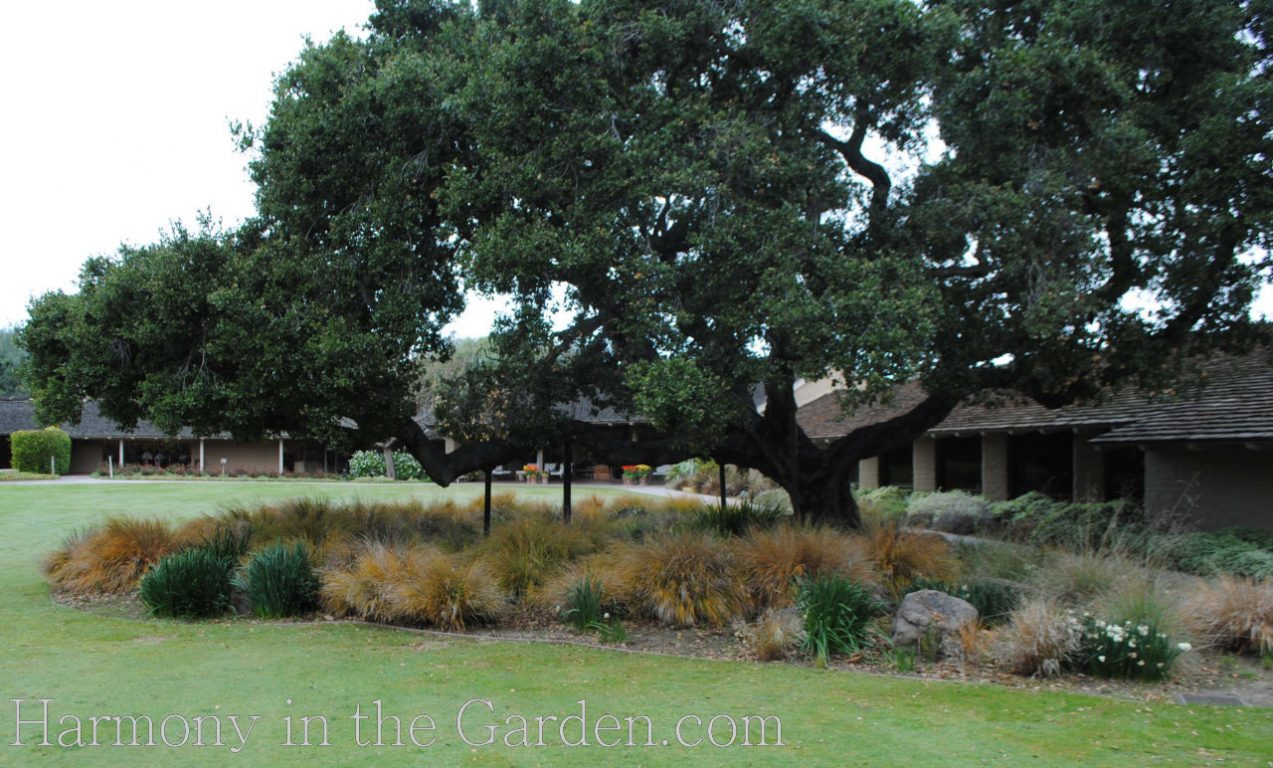
Gardening under oaks and learning to love dry-shade plants go hand-in-hand.
Sensitive to summer irrigation, fertilizers, and root disturbance means creating a garden near an oak tree requires a delicate touch. Indeed, it can be tricky to accomplish.
That’s why the careful selection and placement of dry-shade-loving plants is critical for the tree’s overall health.
(Does anyone recognize this tree? It was the iconic, old oak tree tree located at Sunset Magazine’s Headquarters in Menlo Park. See how they wisely planted low-water plants under it’s drip-line? )
Native to our Mediterranean climate (wet winters followed by hot, dry summer) means the Live Oak trees (quercus agrifolia) that grow in my garden don’t want summer irrigation. The heat from summer, combined with consistently moist soil, will encourage pathogens and root rot in oak trees, often killing them in just a few years.
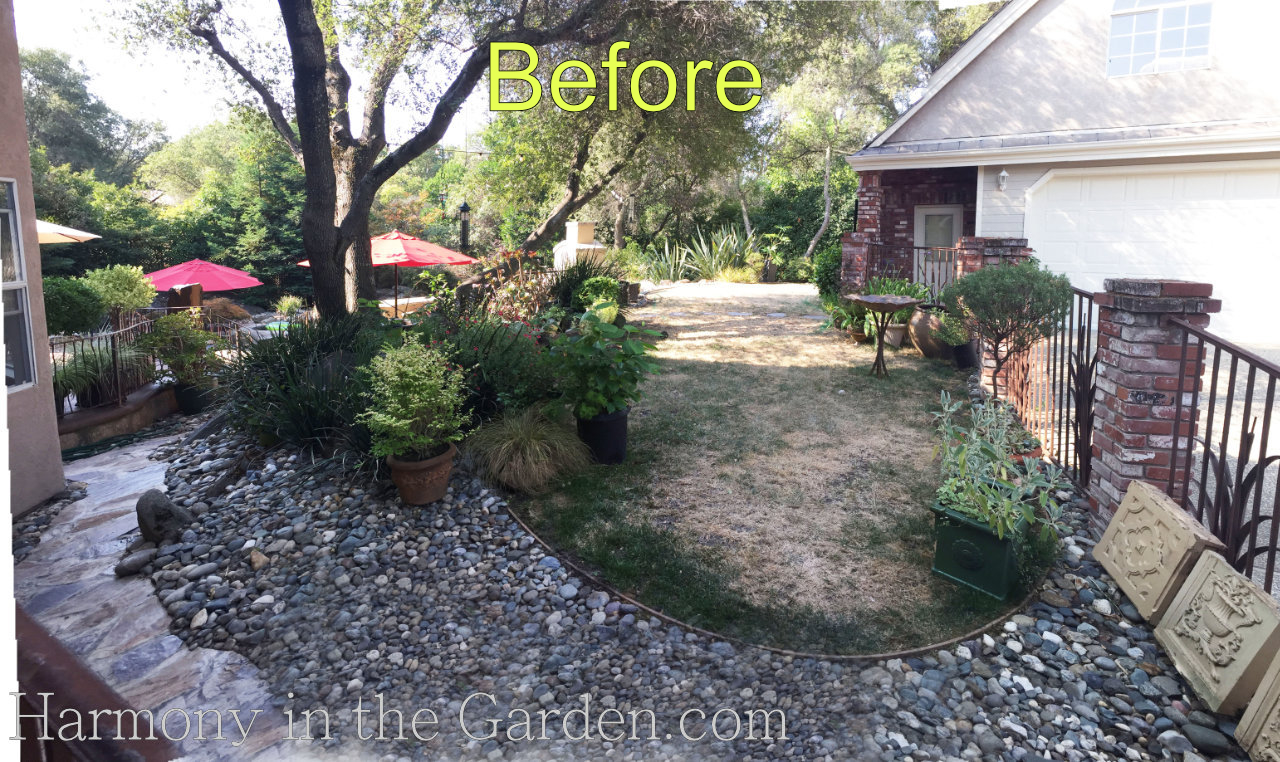
So you can imagine the horror I felt when I first moved into my new home and saw a prominent oak tree in my back garden surrounded by an expanse of water-guzzling lawn.
(You may remember this ‘Rain Garden’ post, where I also had to deal with a dead oak tree that was killed by lawn.)
Even though I have several other oak trees throughout my garden, this one is my favorite.
And because it’s such a special tree, I had to do everything I could to maintain its health.
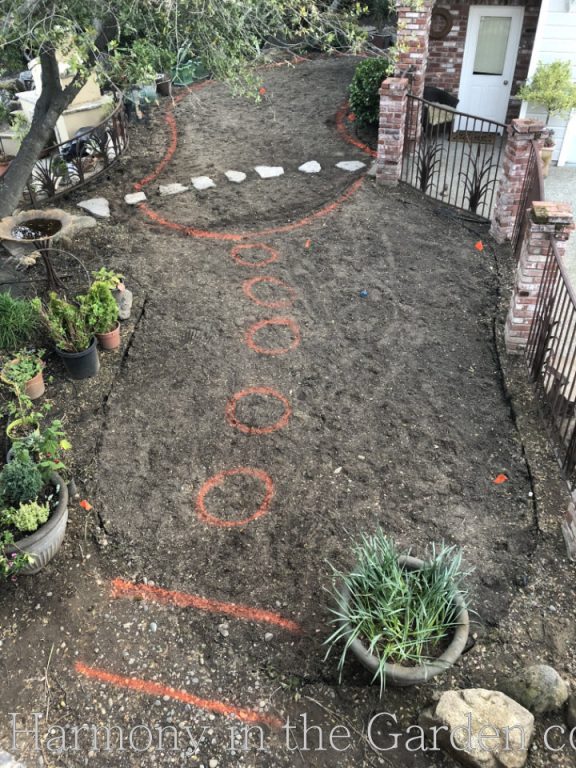
The first thing I did was to slowly reduce the lawn’s water over several months, until the lawn was finally dead.
This allowed the oak tree’s sensitive roots to get accustomed to the change in water, thereby avoiding shocking (and damaging) the tree.
I then carefully removed the dead lawn while the soil was still dry, as wet soil would compact when walked on, damaging the tree’s roots.
Next came the fun part – designing the space!
As I’ve mentioned before, when designing gardens, I like to use landscape paint to experiment with shapes of pathways, garden beds, etc.
This is exactly what I did here, experimenting with the placement of future garden steps that would lead to a new, much smaller lawn (away from the oak tree’s roots.)
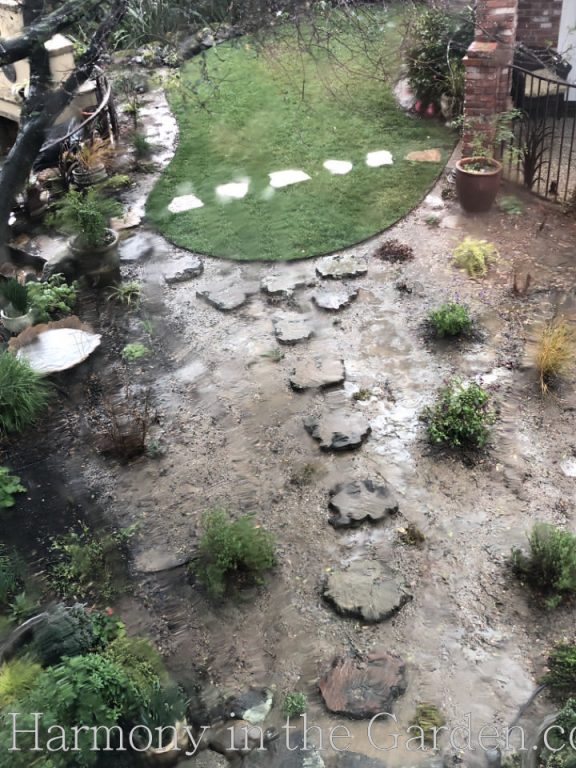
I also needed to address another problem.
This part of the garden sloped down towards the house, which channeled rain runoff right into the side of my house!
So I decided to create a few layers of steps that would fix this problem (you can see the future placement of them in the above photo, designated by the orange lines.)
I knew just the stonemason to use – my mother!
She’s incredibly talented working with rocks of all sizes (my family calls her the rock-whisperer.)
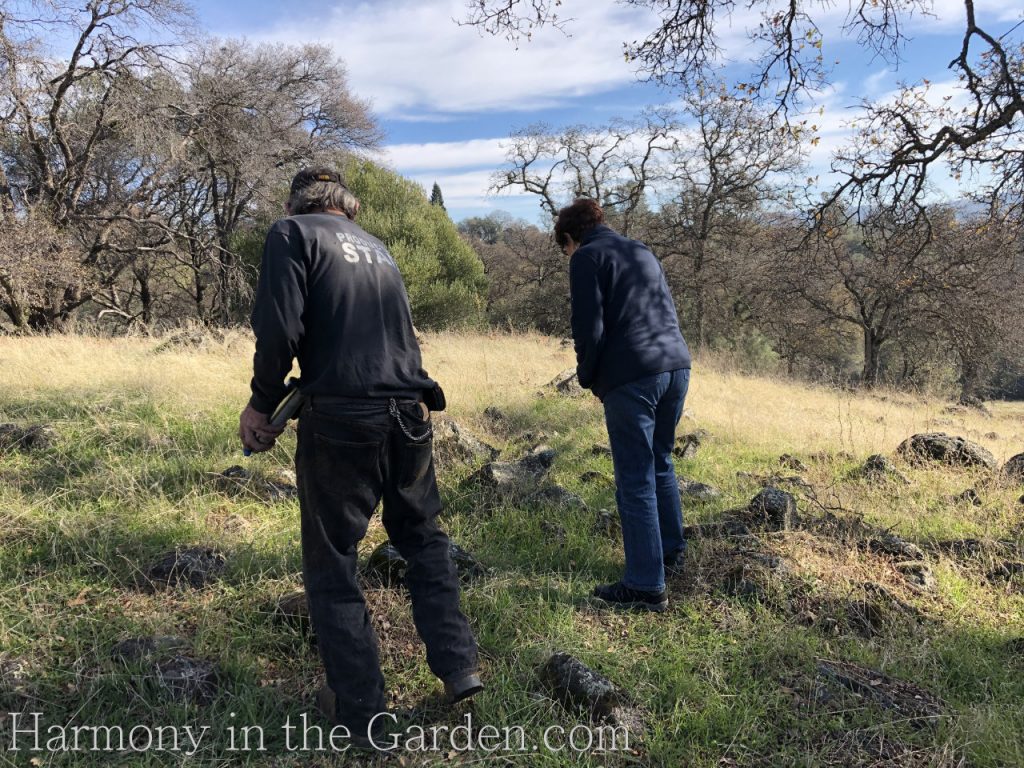
But the problem we faced was trying to source granite boulders that would match the existing ones already in my garden.
After hearing about a-guy-who-knew-a-guy (you know how that goes!), we ended up in the hills at his property, hand-selecting the perfect stones for my future garden steps.
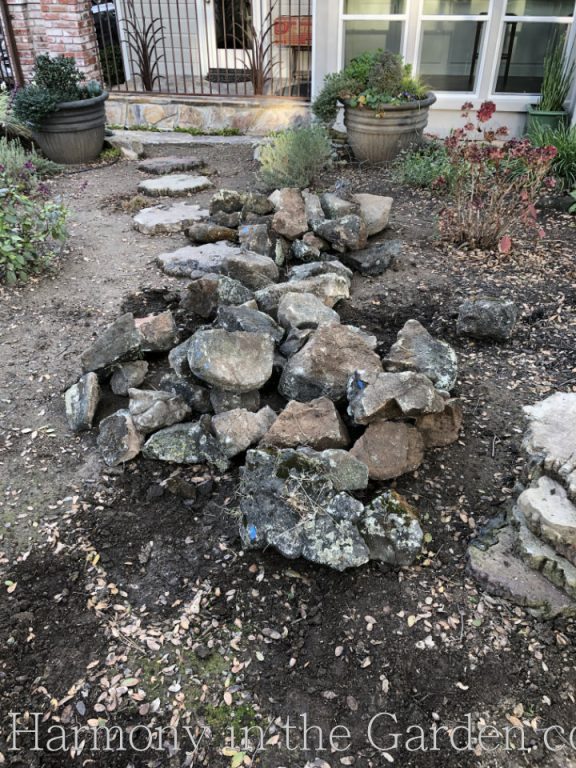

The stones were delivered a few days later and my mother got to work (after first wondering what she had gotten herself into!)
I absolutely LOVE these steps, each stone carefully chosen, placed, and secured by my mother – like a giant jigsaw puzzle.
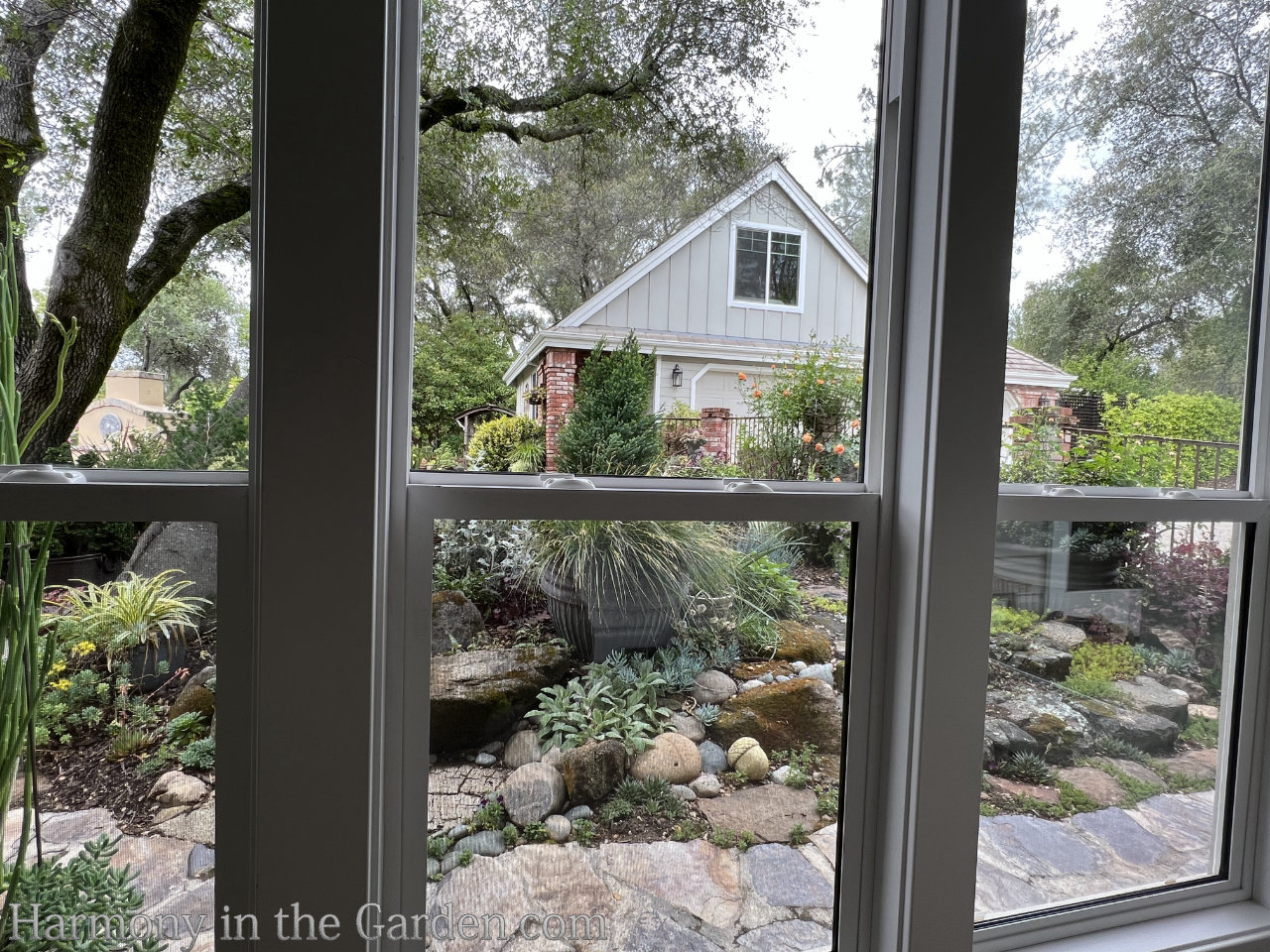
Now that the overall layout of the garden was in place, I needed to focus on the plants.
I realize most experts would advise not planting anything under oaks, but placing the plants (preferably natives) at least 6-feet from the trunk.
However, since this area is so visible from inside my home, I wanted to create a more traditional garden that would blend in with the surrounding planting beds.
So, in order to successfully accomplish this, I kept the following in mind when choosing which plants to use:
1. Oak trees have VERY fragile roots that can easily be damaged by digging large holes for shrubs.
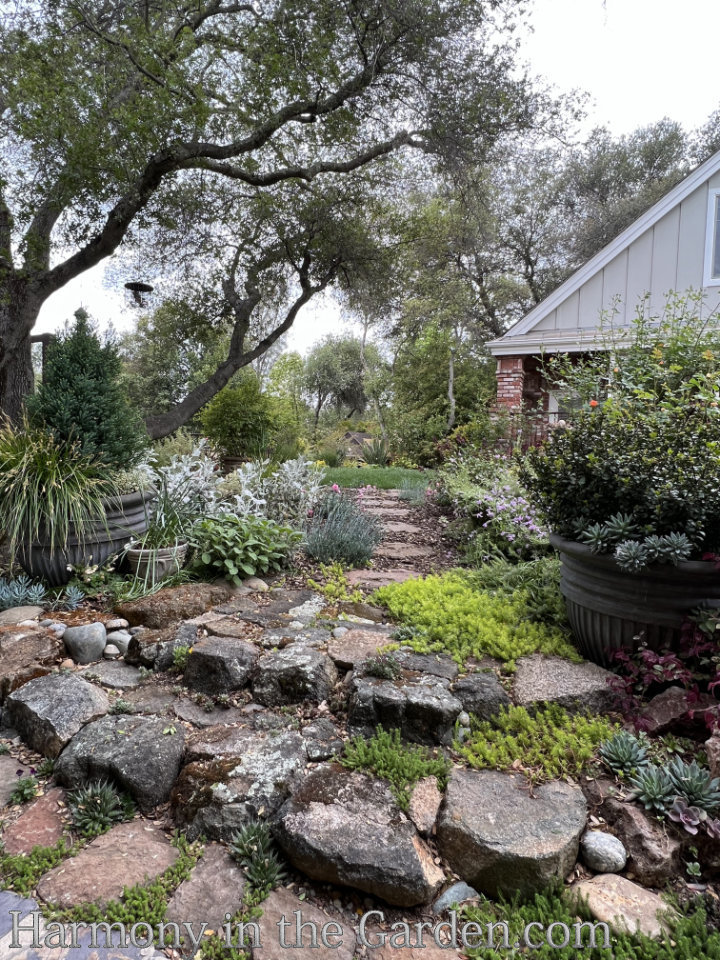
To avoid damaging the tree roots, I planted cuttings and small specimens (nothing larger than a 1-gallon.)
Another trick I used to add height and interest without planting a large shrub in the ground, is placing oversized containers within the garden bed.
I placed two oversized containers on either side of the stone steps, adding a bit of formality, and adding to the ‘traditional landscape’ feeling of the space.
The large containers also allow me to plant larger shrubs in them, adding much-needed height.
The container below (left) contains chamaecyparis thyoides ‘Red Star’ and below (right) is Monrovia’s ‘Scallywag’ holly, with Sunset’s ‘Purple Pixie’ loropetalum at its feet.
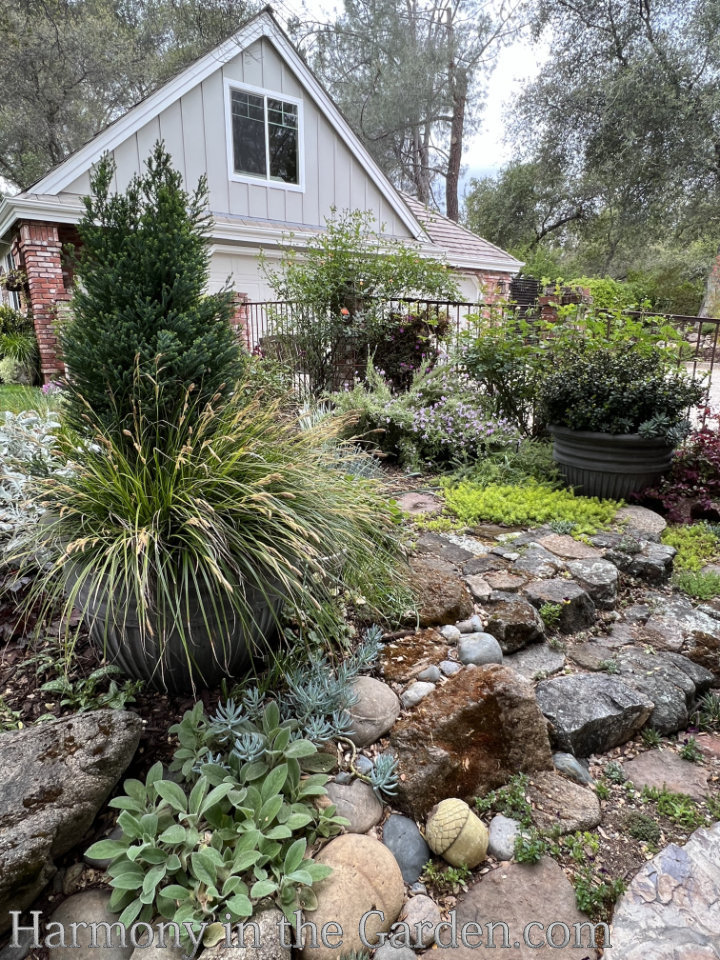
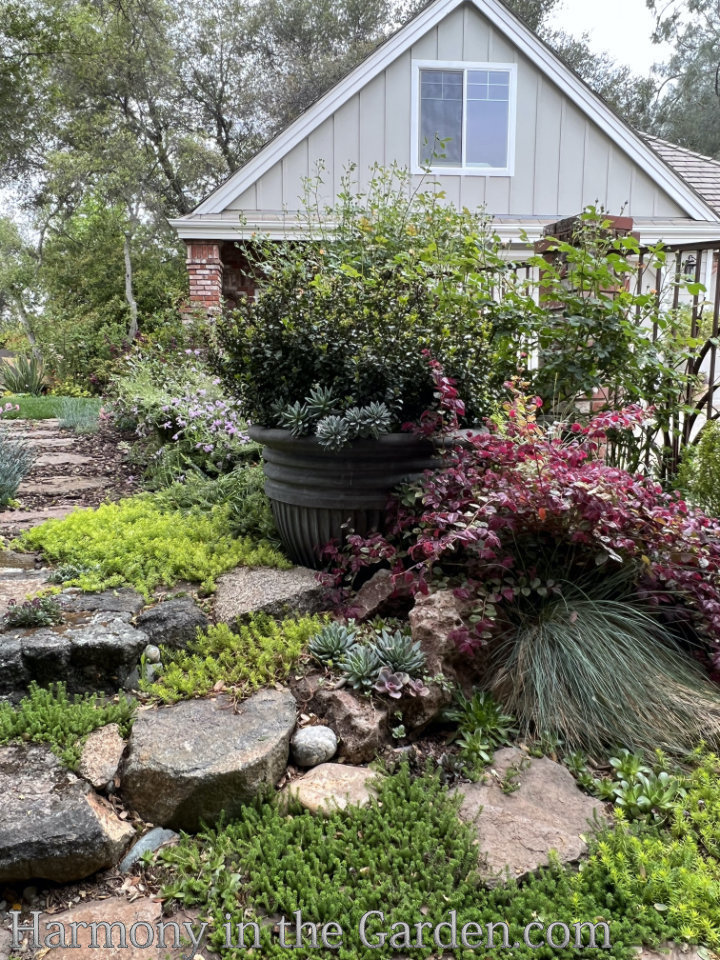

Another plus of using containers placed within the garden bed is that I’m better able to control where to add water.
Using large containers (versus those that are smaller) means the vast majority of the water remains in the containers instead of quickly running out of the bottom.
This is a great strategy when planting thirstier plants (such as the rose planted in the above container.)
Surrounding this container is a mix of dianthus ‘Firewitch’, stachys ‘Primrose Heron’, and geranium ‘Biokovo’.
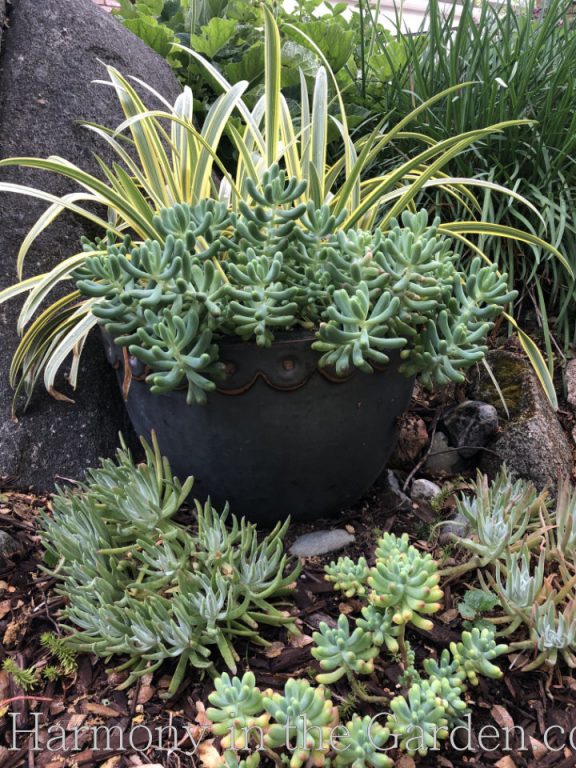
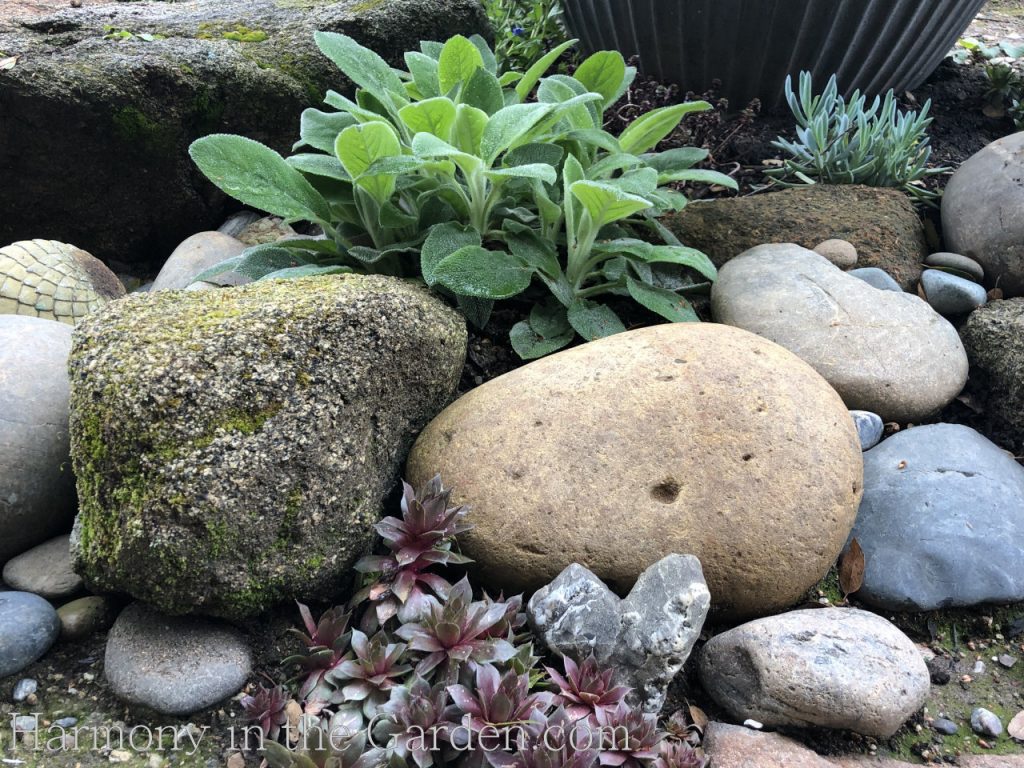
The small amount of water that drains from the container is quickly consumed by the smaller plants at their base.
Plants like succulents and Lamb’s Ears thrive on the little water that escapes the bottom of the containers.
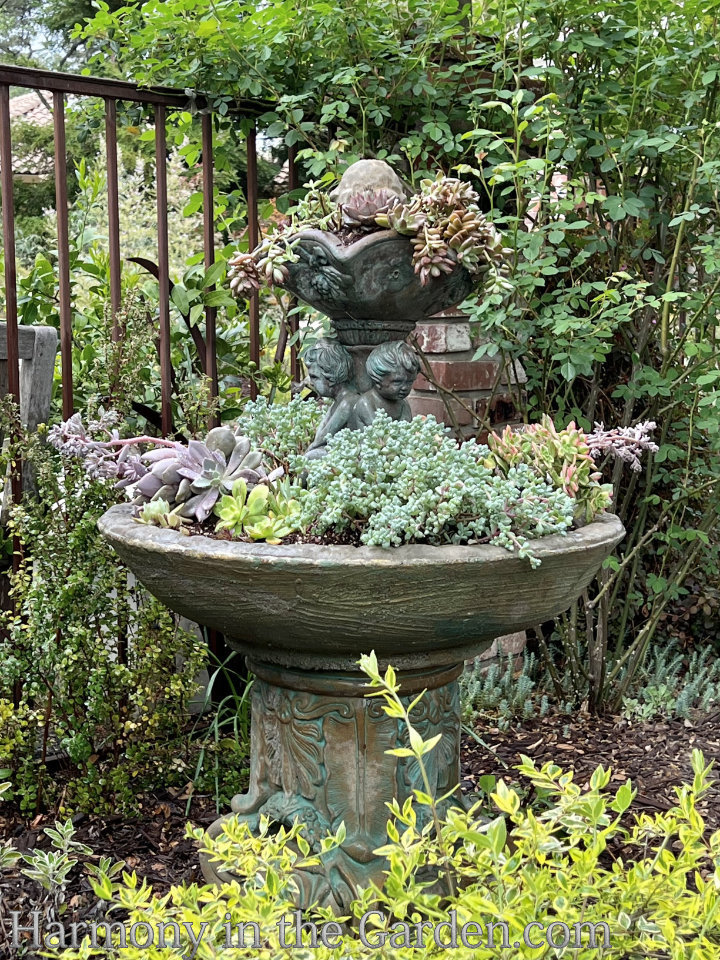

While planting succulents in fountains is nothing new, this is one of my favorite containers of all.
As you can see from the above photo, I’ve had this fountain for over 20 years (that’s my daughter, btw, who’s now almost 27!)
While I no longer use this as a working fountain, it makes an ideal home for a succulent collection. And, any water that gathers from rain easily drains out of the hole in the bottom of the bowls.
2. The roots in the area closest to the Oak tree’s trunk are especially sensitive, so it’s not wise to plant anything next to the tree.

In my garden, however, I made some exceptions.
In addition to the previous wrap-around lawn, there were also large established clumps of society garlic and a cordyline ‘Pink Star’ planted right next to the trunk.
Since these plants were thriving without any additional irrigation, I decided to let them remain. I was concerned I’d damage the roots by removing such large plants.
On the other side of the oak tree is a stone wall, surrounded by boulders that create shallow pockets.
These pockets of soil were ideal for my low-water (and shallow-rooted) succulent collection.
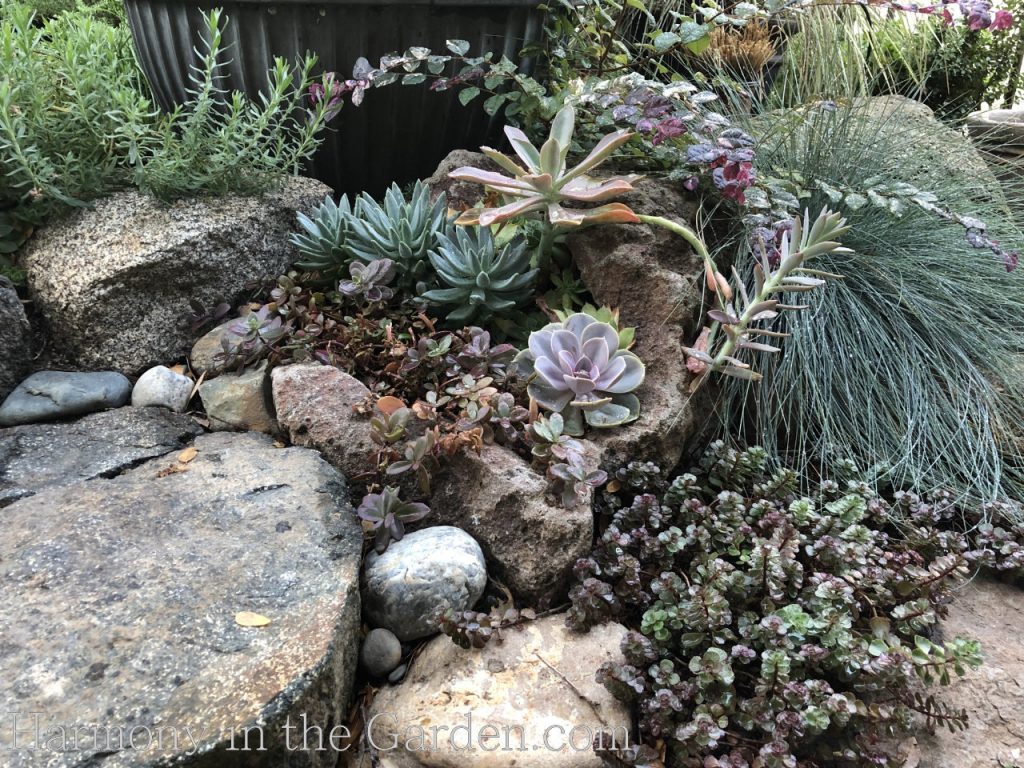

In addition to low water succulents, I’ve tucked in non-living elements as well (lowest water of all – ha!)
Some of my favorites items (shells, unusual rocks I’ve found, trinkets, etc.) have made their way into all the nooks and crannies of this area.

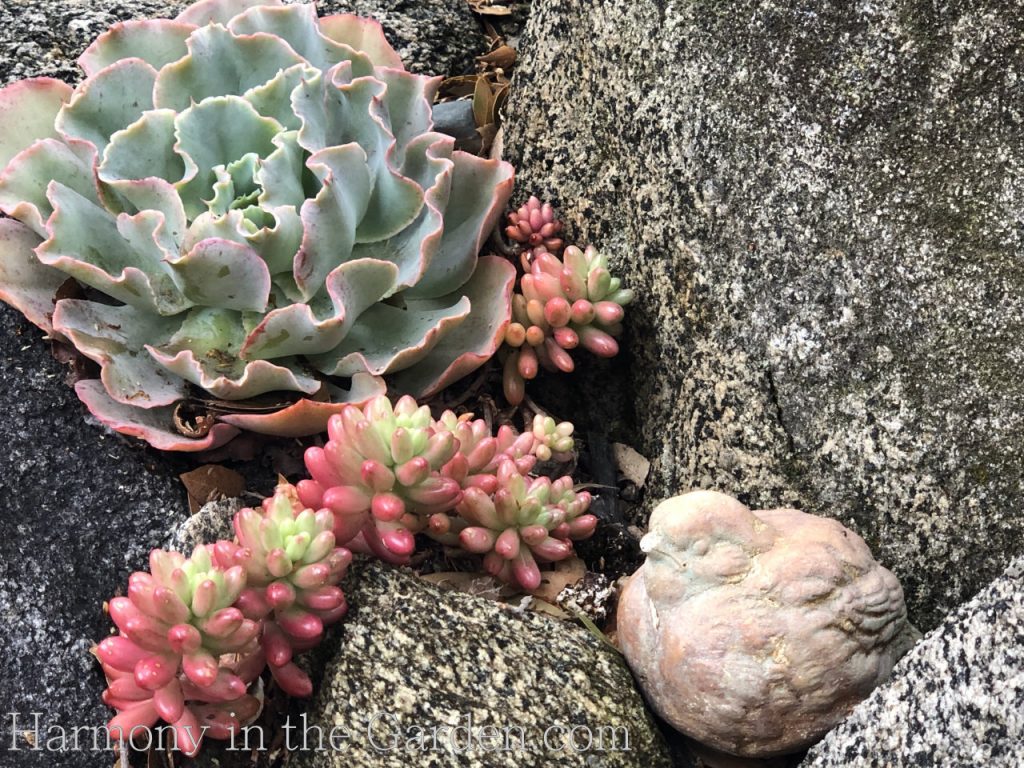

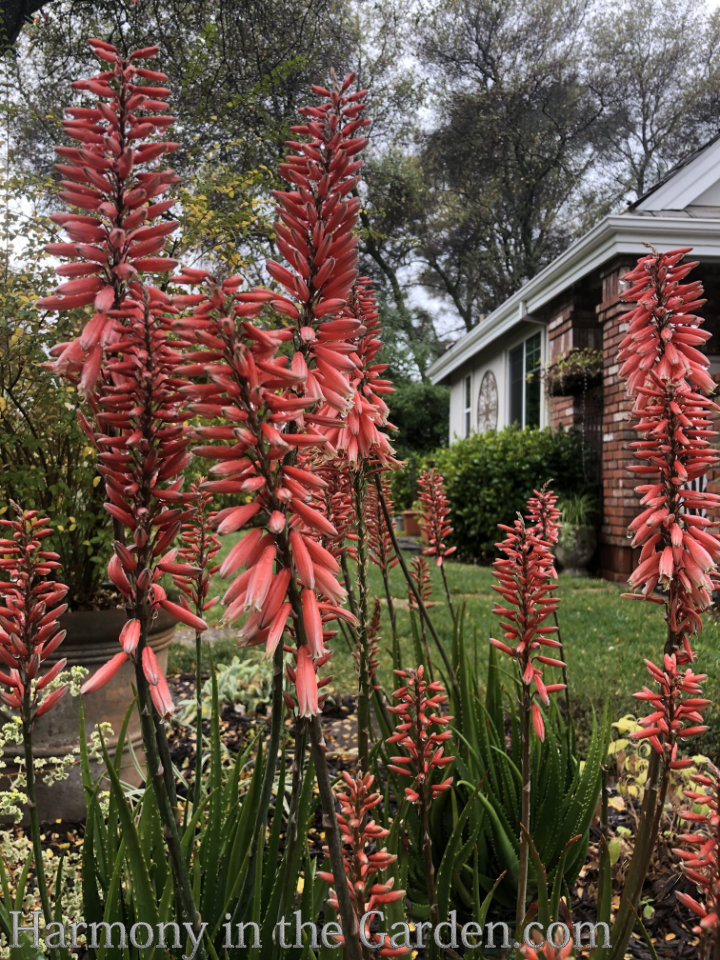
3. Avoid using plants that require consistent feeding.
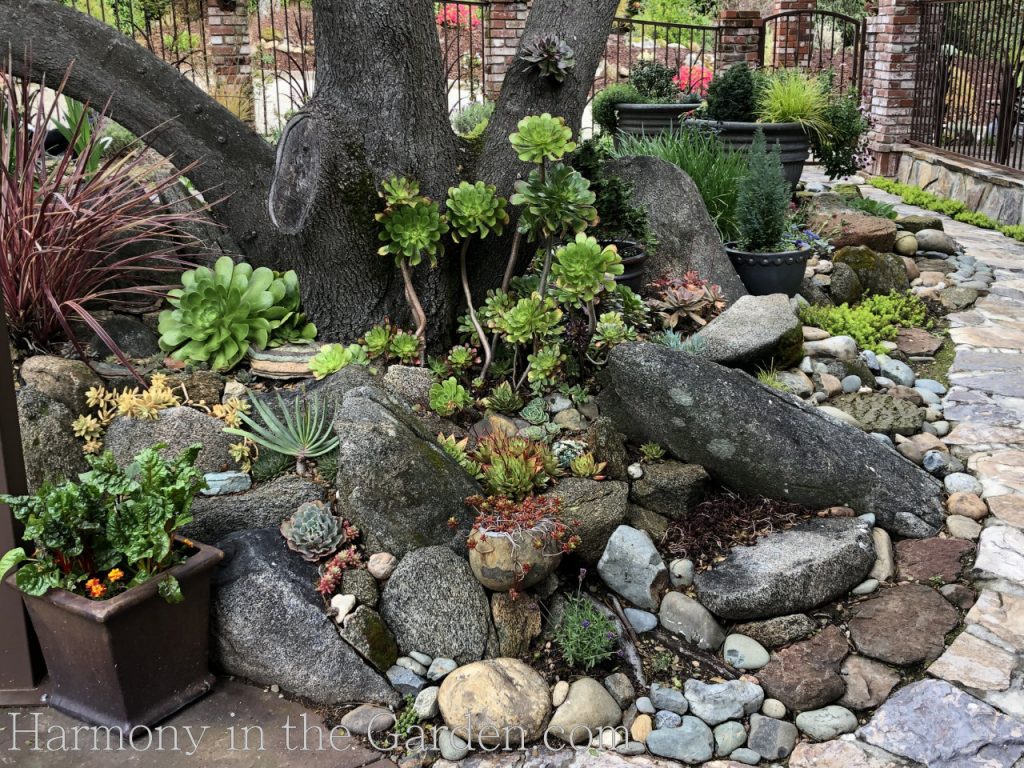
Not only do plants near oak trees need to thrive with little water and the shade cast from the tree, but they shouldn’t require regular fertilizer, either.
Remember -the roots from an oak tree are sensitive to anything non-native to the area!
I also mulch with 2-3” of organic matter, and leave the leaves that fall (though, I do keep them lightly raked when they begin to pile up too much.)
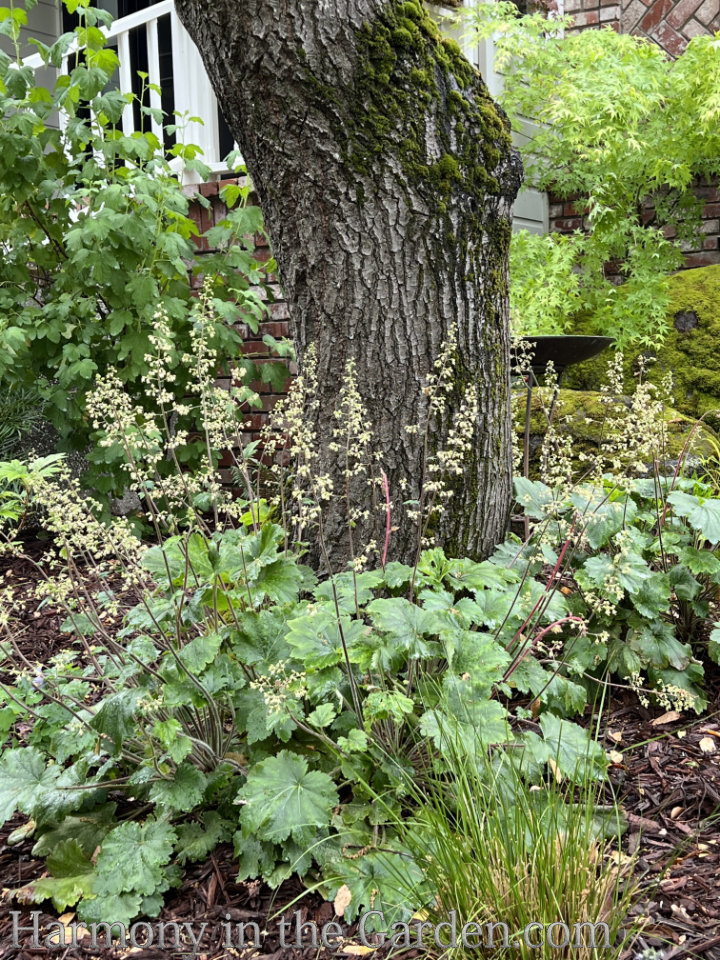
Many people have asked how I water the plants in this area. I irrigate them using individual drip emitters.
However, I run the water as infrequently as I can, depending on the temps outside. I shut off the irrigation during the cooler months, and during the hottest months (above 100 degrees) I’ll water this area once a week.
Some of my favorite native plants that have done really well under my oak trees with no additional fertilization are the heuchera maxima (left) and h. ‘Wendy’ (below.)
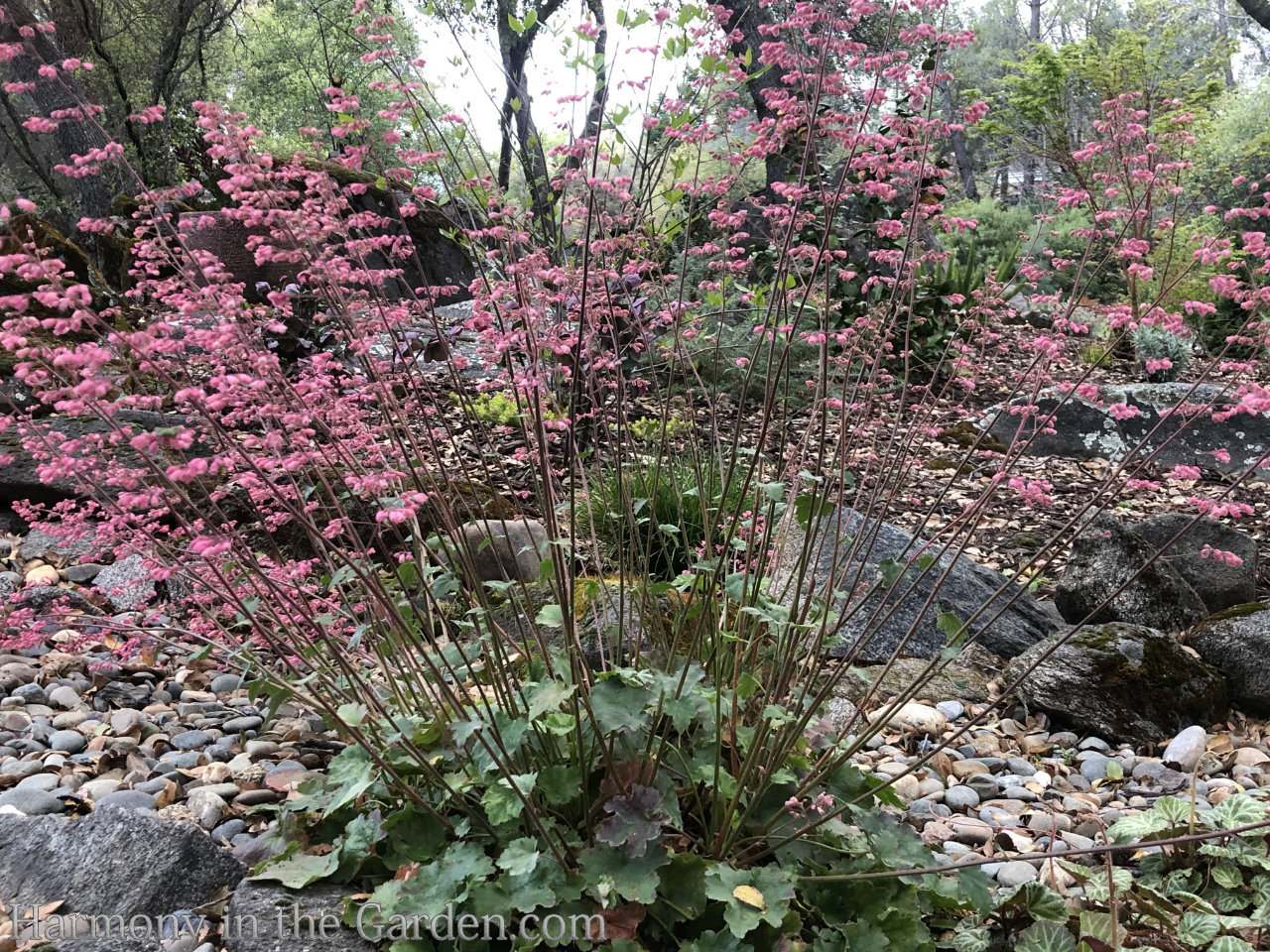
Below are low-water, shade-tolerant native epimediums ‘Ellen Willmott’ (with dainty orange flowers,) and e. sulphureum with its brilliant yellow blooms and maroon-tinged foliage.
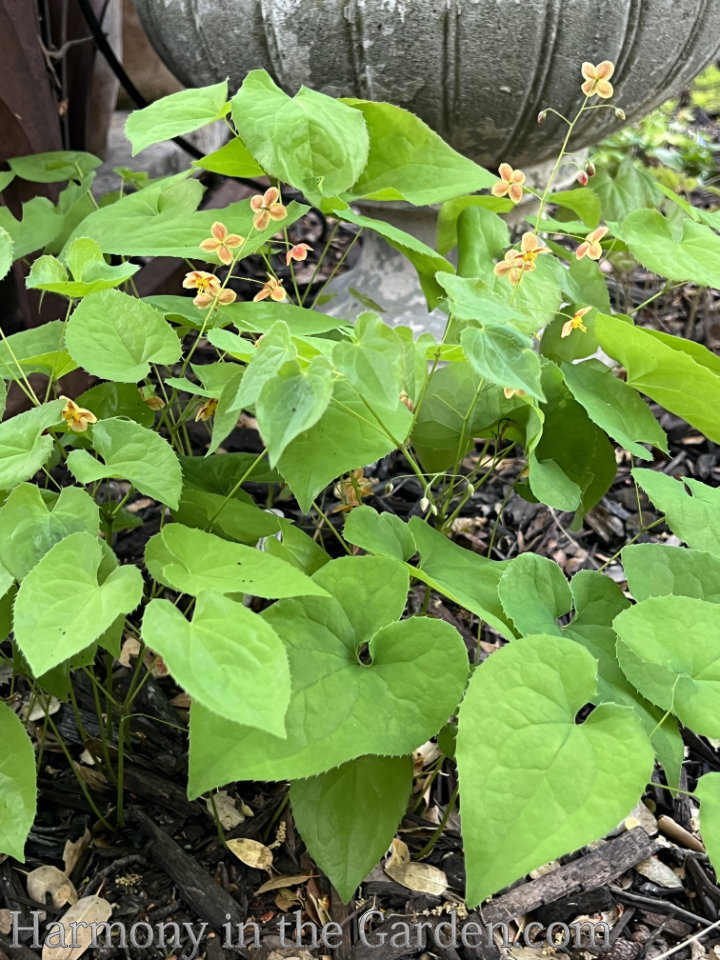
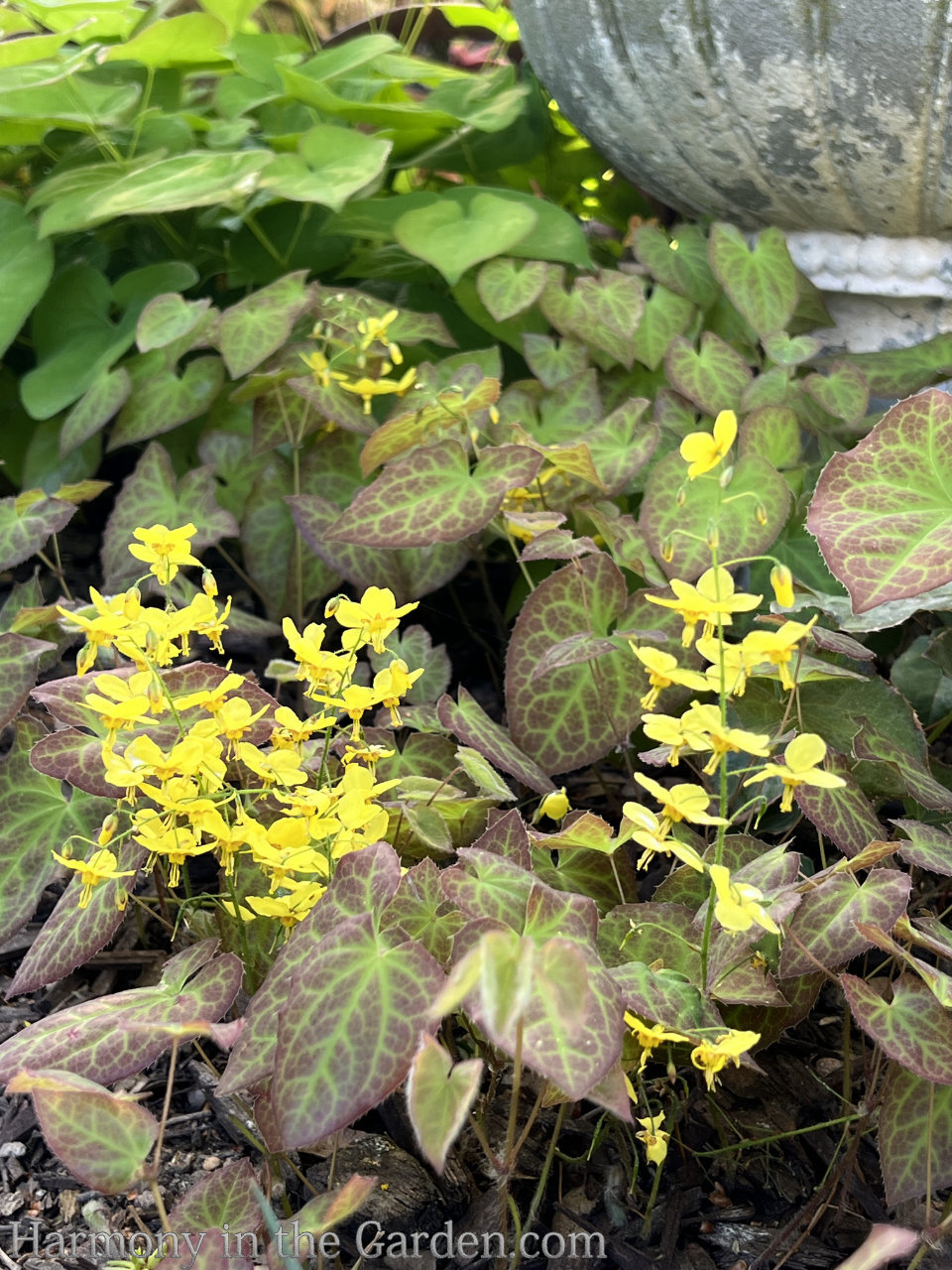
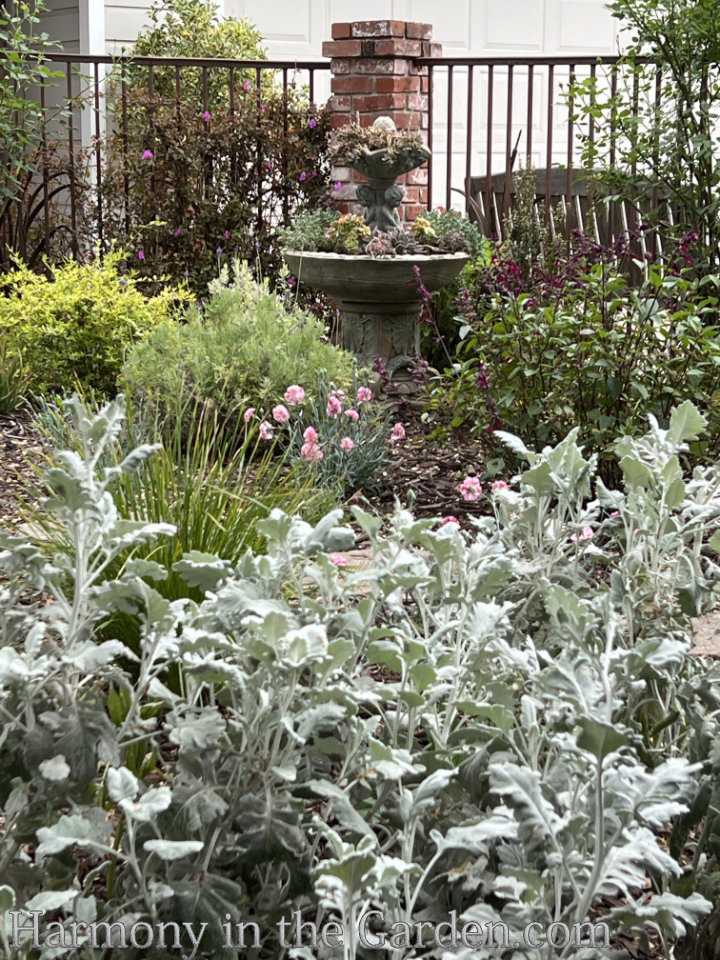
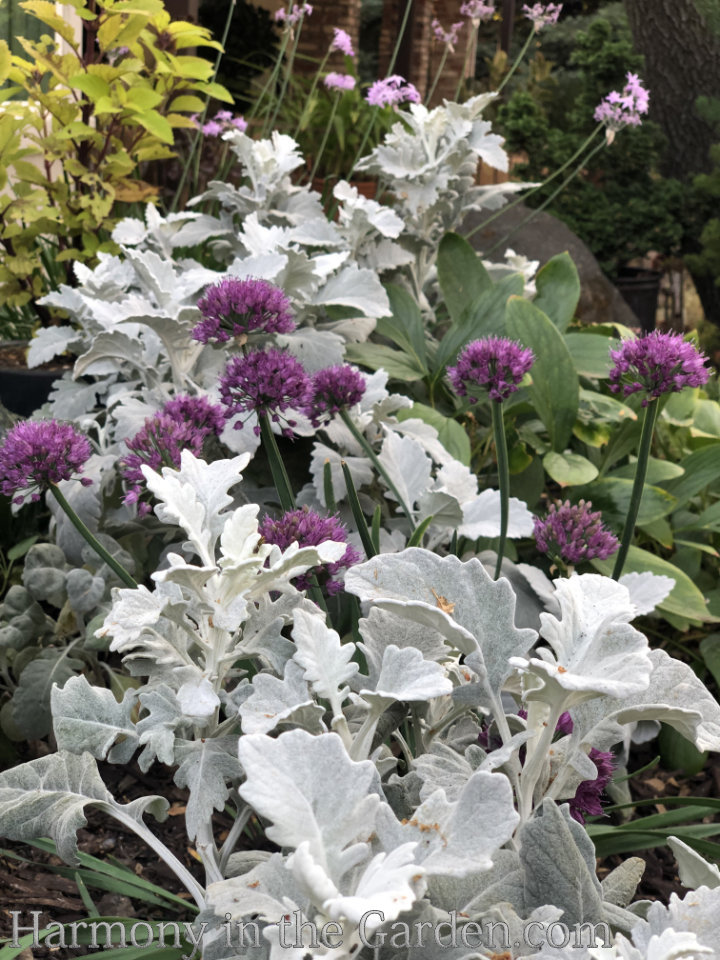
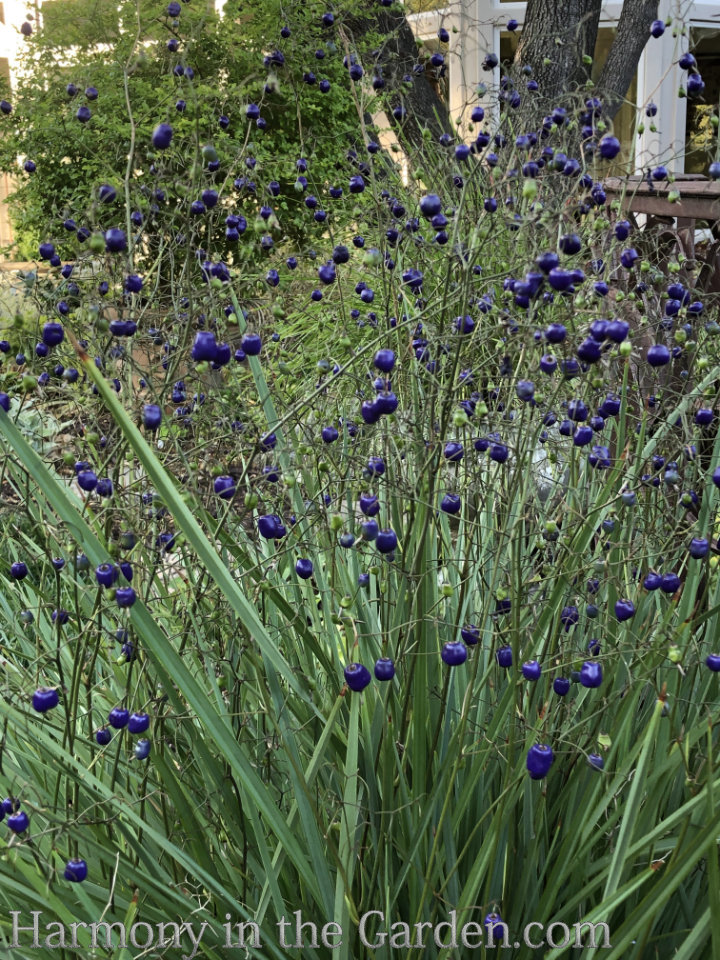
Dianella ‘Cool Vista’ (from Sunset’s Plant Collection) is among my top three favorite grasses and so darn versatile (though I’ll warn you, it does slowly spread to 3-feet wide.)
Click here to see more pics of this grass (including it’s teeny-tiny blue flowers) and how I design with other ornamental grasses.
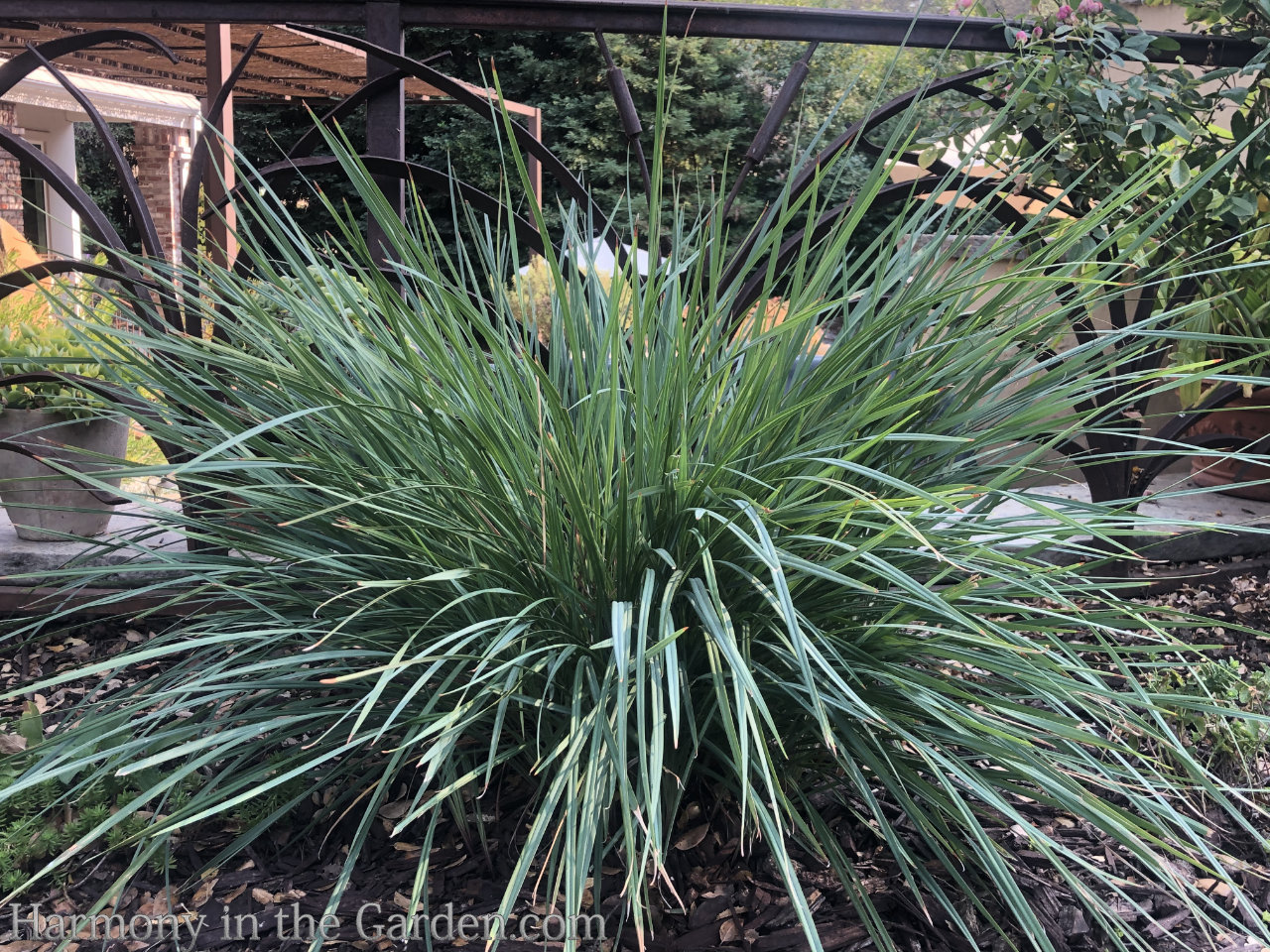
The area outside of the tree’s drip line, is where I indulge in plants that like more sun and water.
Remember the post about my roses? This is the area where they’re planted – right outside of the drip line, along the fence (below.)
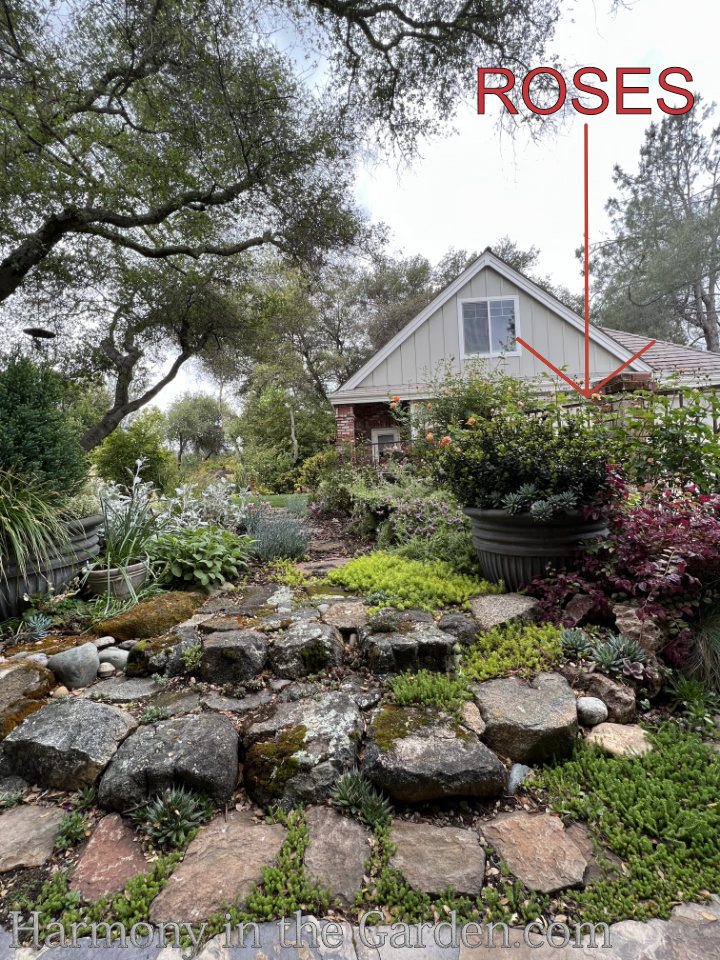

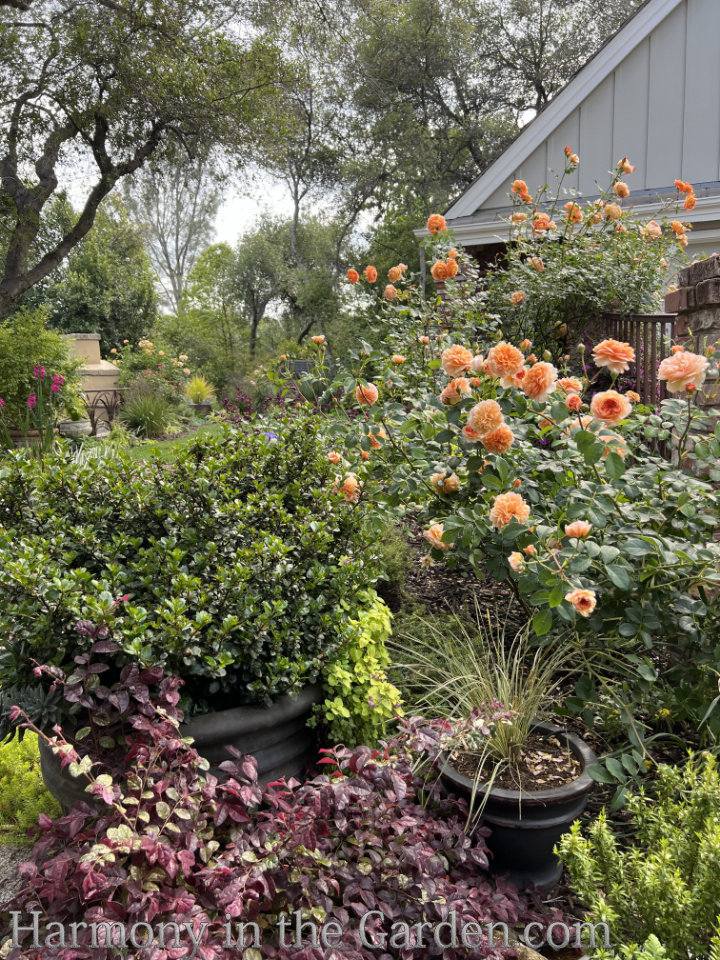
Okay, ready for my (partial) plant list?
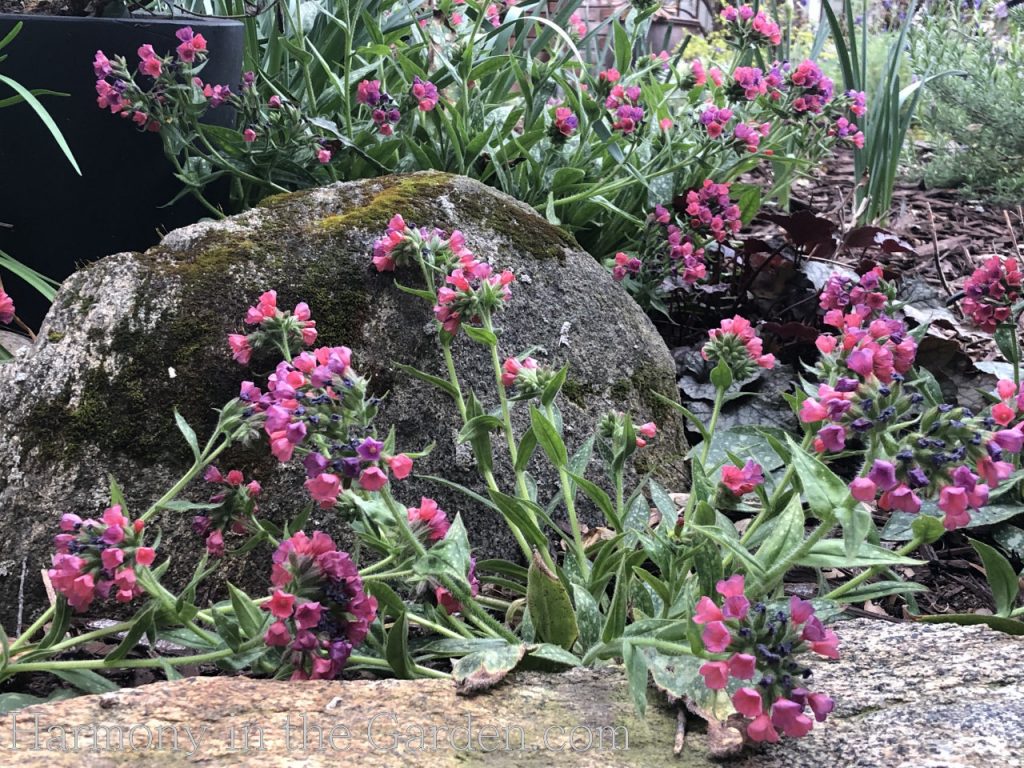
As you’ll see, some plants in this area are native, some aren’t.
However, all are low water, happy in filtered shade, aren’t heavy feeders, and can be found in 1-gallon or smaller containers.
I do irrigate my plants using individual drip emitters, running the water as infrequently as I can, depending on the temps outside.
Pulmonaria ‘Raspberry Splash’ (above)
Salvia spathacea (Hummingbird sage)
Ceanothus ‘Carmel Creeper’, ‘Ray Hartman’, ‘Yankee Point’
Epimedium sulphureum & ‘Ellen Willmott’
Eriogonum grande rubescens
Lavender ‘Meerlo’ (click here for four-season lavenders)
Salvia sonomensis
Euphorbia ‘Diamond Mountain’ (more euphorbias, here.)
Pelargonium crispum ‘Prince Rupert’ & ‘Golden Lemon’
Bergenia crassifolia
Heuchera ‘Wendy’ and heuchera maxima
Tulbaghia violacea (Society Garlic)
Crassula multicava ‘Red’
Agapanthus ‘Summer Skies
Asparagus retrofractus (Ming Fern)
Stachys ‘Primrose Heron’
Geranium phaeum ‘Springtime’
Geum ‘Petticoat Peach’
Salvia elegans (Pineapple Sage) (click here for more salvias)
Muscari ‘Mt. Hood’
Dianthus ‘Whetman Stars’
Sedum pachyphyllum
Strawberry ‘berried treasure’
Chamaecyparis thyoides ‘Red Star’
Iris ‘Albo Variegata’
Festuca californica
Helictrichon sempervirens
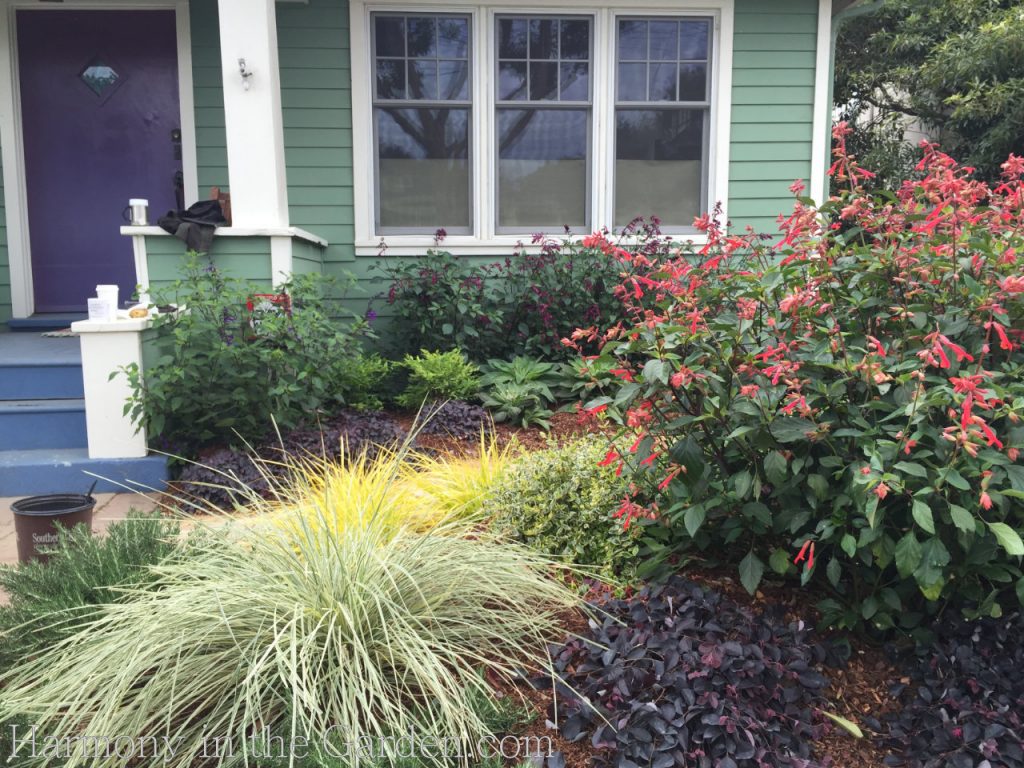
And finally – does anyone remember that sweet little garden I designed for Sunset Magazine?
If not, click here to read the article.
While designing that garden I fell in love with lots of plants in their Western Garden Collection.
And since then, I’ve used their plants in tons of gardens over the years, with the following doing really, really well under my oak trees:
- Salvia ‘Love and Wishes’
- Ligustrum ‘Sunshine’ (yes, it’s a privet, but it doesn’t reseed!!)
- Dianella ‘Coolvista’
- Festuca ‘Beyond Blue’
- Lomandra ‘Platinum Beauty’



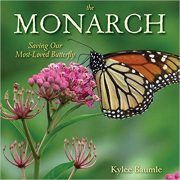


39 Comments
Thank you for writing such a great article! What do you suggest planting under an Oak for colder temps? We are in Placerville and sometimes in the Winter we get overnight temps in the low 20’s, It is not uncommon for us to get a lttle snow. Thank you very much!
Hi Rebecca (and nice to meet another ‘Rebecca’!) You could try some of the ground cover options for manzanita (arctostaphylos), such as ‘Emerald Carpet’. And several geraniums are cold-hardy, too, which would do really well (ie: ‘Biokovo’ ‘Johnson’s Blue’, etc. https://harmonyinthegarden.com/2022/03/geraniums-and-pelargoniums-in-my-garden/ And there’s lots of cold-hardy succulents that even survive in our zone-6 lake tahoe garden which would also work (https://harmonyinthegarden.com/2020/08/plants-for-the-4-cs-corners-cracks-crannies-crevices/) You might also take a look at this post I wrote about planting among tree roots for other ground cover inspiration https://harmonyinthegarden.com/2023/03/planting-around-tree-roots/
This is a great article thank you!
I do have a question about groundcovers that are lawn alternatives that grow under oaks. Most groundcover plants are not really carpet like or can be walked on. Do you have suggestions on groundcover that is walkable, dog friendly and does well in shade and drought conditions?
I would appreciate any insights!
Hi Anuja, I’m so glad you enjoyed this post. The situation you described is definitely tricky, but you might take a look at Kurapia. I’ve seen it growing in partial shade and it was gorgeous. It quickly spreads, and some people consider it invasive if not kept in bounds, but it’s drought tolerant and forms an evergreen mat (depending on your climate, of course) Good luck!
Thank you so much for the response!
I had heard about Kurapia, in fact, some of my neighbors have it as a lawn alternative. They told me it needs full sun or partial sun at the very least, which is why I assumed its not good for my backyard which has 2 huge oaks and maybe filtered sunlight but more shade than sun.
I live in Lafayette CA if that helps you get an idea of the climate. I would love any additional suggestions, thank you!
Hi Anuja, I think it prefers more sun, but I know that here in Granite Bay I’ve seen it scorched with TOO much of our hot sun. I’ve also seen it do really well with our hot sun when planted in partial shade, so you might try it in a small patch first to see how it does. Good luck!
Thanks for the info! Gives me hope for my yard. ? Hoping to get rid of some lawn under a Valley oak. Some of the grass has already been killed, I think, by the tannins put out by the oak’s roots. An adjacent area, outside drip line, but still lots of shade needs work too…. Are there dry shade plants that better tolerate the tannins in the soil?
Your site says you do in person consults in the Bay Area but it looks like that doesn’t include the North Bay (Sonoma County.) Is that correct?
Hi Ellen, I’m glad you enjoyed my post, but unfortunately I don’t know enough about the tannins being toxic to plants growing underneath the trees. I have about 17 oak trees on my property and haven’t experienced any plant death that I could associate with tannins (more likely associated with hungry deer.) Other plants you might consider are mananitas (‘Emerald Carpet’ groundcover and ‘Howard McMinn’ are two of my favorites) salvia spatheca (hummingbird sage), epimediums (Digging Dog nursery has a wonderful variety – I order mine online) carex divulsa (native ‘Berkeley Sedge’ grass) and even shade-tolerant succulents like aloe saponaria – I hope to write another post this summer about the other plants in my garden that do well under oaks, so stay tuned. Unfortunately, I don’t travel to Sonoma for consults but am available for virtual consults if you think that might work. If so, just let me know and we can set something up! Thanks again and best of luck!
This is great information! I’ve been researching what to plant under a pin oak I have in my front yard in Athens, Georgia. A local nursery suggested cast iron plants because they actually thrive under oak trees and are really tough and drought tolerant – and of course they had them for sale. I’d like to see if there’s anything else I can plant, though, especially native plants. There are some great ideas here.
I’m so glad to hear my post gave you some ideas, Heide. One has to be so careful to not hurt the oak tree by too much digging or too much water, so I’m glad you’re researching it and taking your time. I wish you the best of luck! 🙂
I’ve been working backwards chronologically to get caught up – only 2 more to go before my Inbox is clear of your wonderful posts. Those steps!!! Yes, your mother is definite a “rock whisperer”. They are fantastic. The rest of the post is pretty darn good, too, and I appreciate the link to the front yard article. I’ve been struck by this morning’s reading of multiple posts at how much information you always provide. What a wonderful resource for all of us, even if we are in different climate zones. Thank you for all the work you put in to both educating and entertaining your readers.
Hello Barbara, and WOW – thank you for making my day with your comment! I really appreciate hearing that the information I include in my blog posts is helpful (yes, it definitely requires a lot of my time and energy, but I love it!) and it’s so nice to hear that it’s useful. Thanks again and Happy Gardening! 🙂
Hello Rebecca,
Thank you for sharing. The education & inspiration are much appreciated.
Question: I see the stones from the field went through a step of being cut to the same height. Where does one have this done? Is it expensive?
Thank you.
Hi Eve, believe it or not the stones weren’t cut at all. Each was hand-selected based on if they had flat spots on one or more sides that could be fit together for the stairs. As I mentioned in my blog post, my mother is a master at working with stones (I call her the ‘stone whisperer’)
Such an amazing transformation….. in a relatively short time! So beautiful and such fun to see. Your mom’s stonework is special!
Thanks, Marilee, I’m glad you enjoyed the post! 🙂
Thank you for your helpful and informative blog. I’m hoping you can provide me more information about leonotis menthifolia, it has great orange color. I purchased it in bloom and now wonder if I cut it back will it bloom again this year?
Hi Janis, in my experience you might get a sporadic second bloom so I’d definitely go ahead and prune it a bit. The menthifolia (versus the leonura, which I have) doesn’t get woody (like mine does) so by cutting it by 1/3 it should maintain it’s lush shape, and hopefully a few more blooms this year.
Are you talking about any variety of oak tree or only live oaks? I have white oaks in NW Arkansas and have planted Annabel hydrangeas and giant host as around them. The deer decimate the hostas and I am always on the outlook for dry shade plants, especially deer-resistant ones.
Hi Susan, I’m really talking about the oak trees that grow in my area (the Live Oaks.) I looked up your beautiful White Oak (lucky you!!) and according to this site, they can tolerate a lot more moisture than ours can. https://www.mortonarb.org/trees-plants/tree-plant-descriptions/white-oak I think it’d be worth it to try some of the plants I’ve listed if they’re zoned for your area. The deer will hopefully leave them alone, and your oak tree shouldn’t be damaged by them.
Thank you for your answer. I do plan to try some things on your list. Deer are more of a problem than oaks!
Thank you for the link to the Sunset Western Garden Collection. I’m always looking for new, and different plants to try in my garden-like yours, it has particular challenges to be overcome! I love how you under planted the oak and integrated it into the rest of your garden. And your mother’s rock placement!! Fabulous! I have built small dry stacked river stone retaining walls and it is SO hard to keep it from looking like a random rock slide. Nothing like trying to do something yourself to realize how difficult it is! I recently went to a market at Newcastle Lavender Farms, and they had some marvelous retaining walls built from rocks.
You’re so welcome, Cheri! Since you live in the area, Green Acres sells a few plants from the Sunset Collection (I just bought another ‘Meerlo’ lavender yesterday, in fact, to go under another oak tree!) Thanks for letting me know about Newcastle Lavender Farms – that’s a new one for me and I’ll make sure to check them out next year. And I wholeheartedly agree about the level of difficulty in making stone walls. Which is precisely why I don’t make them (it’s a talent which didn’t pass down from my mother to me!!) 😉
Your articles are always interesting. I live in Newcastle and have nothing but oak trees. I planted Rhamnus californica Coffeeberry the evergreen shrub that grows 1-2 ft high and 6-8 ft wide.. It gets very little water and is on a sloping hill. I try to keep plants away from the base of the oaks so they can get good air circulation. We also have Toyon which I try to keep trimmed.
Hi Judy, and thank you! I also have 2 large coffee berries but they’re at least 8′ high – I wonder what variety you have that stays so short? There’s one called ‘Sea View’ that stays around 2-3′ high but I haven’t seen it anywhere for sale around here. Yours would be the perfect size for another area I have in mind.
A beautiful transformation and I love that your Mom had a key role in it — my Mom taught me to garden and I’m never without her when I’m out there, I like to imagine her in that heavenly garden without weeds! You have an amazing gift of making things beautiful and tenderly caring for the earth. Enjoy your beautiful new retreat!
Thank you, Joan! Aren’t we lucky to have mothers who taught us so much about gardening? I’m with my mom today at our Lake Tahoe garden, just back from the nursery and heading out in the 20mph wind to plant. It’s SO difficult to garden up here, but so much fun doing it with my mother. We console each other when the elements foil our best-laid plans – ha!
I love stone! A stone wisperwr In The family is trulu a gift!
<3
Nan
Hi Nan, you’re absolutely right – we’re so very lucky to have a stone whisperer in our family!
FYI Geranium macrorhizum is a wonderful perennial for dry shade under cedar trees. It has shallow roots, easy to move, divide, remove, very little digging to do. For divisions, just lie the division long root down sideways, cover with soil, water & it will grow. I never water it except initial planting/transplanting & no fertilizer required. it discourages weeds & It flowers briefly in colours of light purple, reddish, & also a white cultivar, leaves have a slight pleasant scent of myrrrh. Deers ignore it. It is evergreen in the pacific northwest., always looks neat & tidy & well behaved.,not a thug.
Thanks so much, Bet! I have lots of geranium cantabrigiense ‘Biokovo’ (the light pink flowered one) which I failed to put on my list, but haven’t tried the G. macro you recommended. Next time I head to the nursery I’ll definitely look for some.
Oh my gosh, this is all the information I’ve been looking for (and more!) wrapped up in to one awesome post. So helpful and timely! Thank you!
To be honest, Courtney, your last comment on my other post (asking about other dry shade ideas) made me realize I should really write about this part of my garden – I was hoping it would help you! So glad it gave you some ideas. 🙂
Thanks for sharing the thoughtful design process involved in creating these beautiful garden beds! Your mom’s stonework is indeed amazing!
Thanks, Sue – I’ll pass along the compliment to her (we’re in the process of heading out to the garden right now, up here at Lake Tahoe, to dig some giant holes for new plantings – she’s definitely a hard worker!!)
This post is an inspiration. Have you ever designed under an olive tree?
Thank you, Bernie, I appreciate that. Yes, I’ve designed under olives (mainly the non-fruiting varieties like ‘Majestic Beauty’ and Wilsonii as otherwise it’s way too messy.) I wish I had some photos, but I don’t think I do – if so, I’ll post them. I had a beautiful combination of aeonium canariensis and dymondia growing in a mound at the base of a beautiful, old olive tree. As well as lavenders, santolina, salvia sonomensis. Here’s an article that might inspire (they’ve got some phormiums, lavender, and other low water plants featured https://www.gardenista.com/posts/simple-landscaping-ideas-10-genius-gardens-with-an-olive-tree/)
I’m impressed with the plants selected, as had no idea so many would thrive in shady dry conditions. You’re so creative! May I see your gardens in person, someday?
Thanks, Marianne, and yes we need to plan a visit soon – maybe if this darn Coronavirus ever decides to fade away? ugh!!!